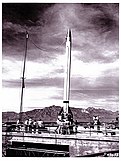From today's featured article
Operation Flavius was a military operation in which three members of the Provisional Irish Republican Army (IRA) were killed by the British Special Air Service (SAS) in Gibraltar on 6 March 1988. The three were believed to be mounting a car bomb attack on British military personnel, but they proved to be unarmed and no bomb was discovered. This event started a violent spree in which mourners were killed at the funeral of the IRA members, then two British soldiers were killed after they accidentally drove into a funeral procession for one of the mourners. A documentary, "Death on the Rock", was televised on 24 April 1988 and presented the possibility that the three IRA members had been unlawfully killed. An inquest ruled that the SAS had acted lawfully, but the European Court of Human Rights held that the planning and control of the operation was so flawed as to make the use of lethal force almost inevitable, a breach of Article 2 of the European Convention on Human Rights. (Full article...)
Did you know ...
- ... that Rembrandt liked the Jan Lievens painting The Raising of Lazarus (pictured) so much that he acquired it for himself?
- ... that the singer Luci van Org followed up her mainstream success from the 1990s by starting a "Latin–disco–pop–country crossover" band?
- ... that a pond of liquid sulfur was discovered at the summit crater of the Daikoku Seamount in 2006 in the Northern Mariana Islands?
- ... that before John McClaughry was elected to the Vermont House of Representatives, he traveled about 5,000 miles (8,000 km) in boxcars as a hobo?
- ... that David Bowie's song "Let's Dance" began as a folk song?
- ... that the rebooted design of Glimmer from She-Ra was partly inspired by the showrunner's love of Dungeons & Dragons?
- ... that the Evans Bay Patent Slip was built in 1871 using hundreds of tons of machinery that had sat on a beach for five years?
- ... that the "Barry White of tennis" is a French chair umpire?
In the news
- In the Estonian parliamentary election, the Reform Party, led by Kaja Kallas (pictured), wins the most seats in the Riigikogu.
- Bola Tinubu, of the ruling All Progressives Congress, is elected President of Nigeria.
- A train crash in Thessaly, Greece, kills at least 57 people.
- At least 67 migrants are killed in a shipwreck off the coast of Calabria, Italy.
- On the Adamant wins the Golden Bear at the Berlin International Film Festival.
On this day
March 6: National Heroes and Benefactors Day in Belize (2023)
- 1853 – Giuseppe Verdi's La traviata premiered at La Fenice in Venice, but the performance was considered so bad that it caused him to revise portions of the opera.
- 1933 – The Nazi Party took the first step in the Gleichschaltung process by passing the Enabling Act, giving the government the right to make laws without the involvement of the Reichstag.
- 1964 – In a radio broadcast, Nation of Islam leader Elijah Muhammad announced that American boxer Cassius Clay would change his name to Muhammad Ali (pictured).
- 1987 – The ferry Herald of Free Enterprise capsized while leaving the harbour of Zeebrugge, Belgium, killing 193 people on board.
- Ella P. Stewart (b. 1893)
- Ayn Rand (d. 1982)
- Francisco Xavier do Amaral (d. 2012)
From today's featured list
The year 1951 saw extensive exploration of space by the United States and the Soviet Union using suborbital rockets. The Soviet Union launched their first series of biomedical tests to the Kármán line, the 100-kilometre (62 mi) boundary of space. Several American agencies launched more than a dozen scientific sounding rocket flights between them. In August 1951, the United States Navy launched Viking 7 (pictured), the seventh in the Viking series of sounding rockets since 1949, this time reaching a record-breaking altitude of 136 miles (219 km). Development also continued by both superpowers on rockets more powerful than the World War II–era German V-2 that had inaugurated the age of spaceflight. (Full list...)
Today's featured picture

|
Tirumala limniace, also known as the blue tiger, is a butterfly found in South Asia, and Southeast Asia, which belongs to the brush-footed butterfly family, Nymphalidae. It is a large butterfly with a wingspan of 90 to 100 millimeters, with the males being smaller than the females. The upper side of the wing is dark brown to black and patterned with bluish-white, semi-transparent spots and lines. This male blue tiger, of the subspecies T. l. exoticus, was photographed in Kumarakom, in the Indian state of Kerala. Photograph credit: Charles J. Sharp
Recently featured:
|
Other areas of Wikipedia
- Community portal – The central hub for editors, with resources, links, tasks, and announcements.
- Village pump – Forum for discussions about Wikipedia itself, including policies and technical issues.
- Site news – Sources of news about Wikipedia and the broader Wikimedia movement.
- Teahouse – Ask basic questions about using or editing Wikipedia.
- Help desk – Ask questions about using or editing Wikipedia.
- Reference desk – Ask research questions about encyclopedic topics.
- Content portals – A unique way to navigate the encyclopedia.
Wikipedia's sister projects
Wikipedia is written by volunteer editors and hosted by the Wikimedia Foundation, a non-profit organization that also hosts a range of other volunteer projects:
-
Commons
Free media repository -
MediaWiki
Wiki software development -
Meta-Wiki
Wikimedia project coordination -
Wikibooks
Free textbooks and manuals -
Wikidata
Free knowledge base -
Wikinews
Free-content news -
Wikiquote
Collection of quotations -
Wikisource
Free-content library -
Wikispecies
Directory of species -
Wikiversity
Free learning tools -
Wikivoyage
Free travel guide -
Wiktionary
Dictionary and thesaurus
Wikipedia languages
This Wikipedia is written in English. Many other Wikipedias are available; some of the largest are listed below.
-
1,000,000+ articles
-
250,000+ articles
-
50,000+ articles




